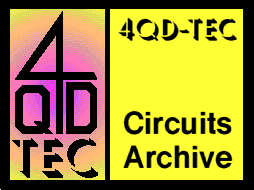

|
4QD-TEC
|
|
You may notice that we don't generally specify transistor types numbers. This is because there are generally only two types of bi-polar transistor, NPN and PNP! The number written on the case generally doesn't matter in the slightest.
4QD use BC556C/557C/558C for PNP and BC546C/547C/548C for NPNs.
Transistors such as these generally come in families of three, so that BC 556, BC557 and BC558 are a 'family' as are BC 546, BC547 and BC548.
The 'C' suffix (e.g BS557C) indicates the gain grouping: generally A is 100-250, B is 200-500 and C is 400-1000.
Then some families have an L suffix as well, so you could have BC546L (or even BC546AL): these L suffixed ones have the collector in the centre. The types 4QD we use are not L types (actually ours are K suffix, or no suffix) and the pins are as in the diagram below, left. We can supply packs of 100 transistors at a very competitive price!

Also shown (centre) is the pinout for the K suffix types.
Note that European transistor types (such as BCxxx) and American types (such as 2n series) are reversed. C and E are interchanged! An American type is shown also above.
Apparently the original TO92 was a plastic version of the popular TO18. The leads in this come out in a triangle. and if this is viewed from the leads, triangle apex upwards, its leads are in the same order as the European version. The story I have heard us that, in the very early days, some large American manufacturer ordered n million transistors from a Japanese manufacturer and, when they were delivered, they gad been made the wrong way round, with collector and emitter interchanged. This was born the reversed, American standard.
The good news is that in most cases, if you reverse a transistor, you won't usually blow it up, it simply won't work - though transistors do work, after a fashion, if you swap collector and emitter.
On the right of the diagram are shown the diagrammatic symbols for NPN and PNP transistors, with the emitter, base and collector identified. The arrow is always on the emitter and points is the direction of conventional current flow. Now current was defined long before the electron was discovered and was defined as flowing from positive to negative. When electrons were discovered and identified as being the real thing that moved when current flowed: shock! horror! They moved the wrong way! So some bright spark gave them a negative charge, which of course meant they constituted a negative current and therefore flowed backwards.. All was correct again - if very confusing to the beginner!
Now NPN transistors are slightly easier to make than PNP (or were so at one stage) and so they are more common than PNPs in most circuits (though not perhaps too much so on this site!). Therefore most electronic circuits are conceived for NPN transistors, which have the negative voltage on their emitter. So NPNs usually have their emitter at the bottom and PNPs at the top. But it's possible to draw circuits the wrong way up - so beware!
Diodes
Diodes are - diodes... Circuits are not cruticalmand, unless otherwise specified and small signal diode will do. One common numbers is 1N4148.
| 4QD Sites: |